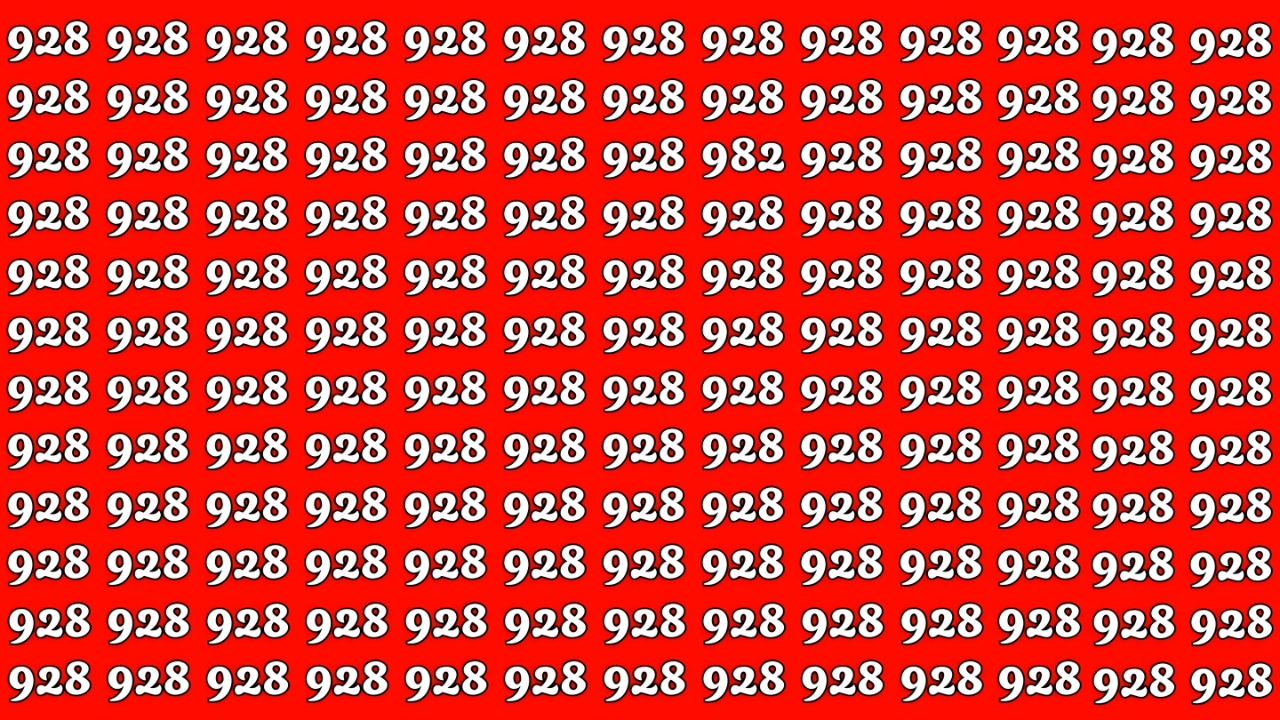Spot the Number 982 : Optical illusions and visual challenges have long captivated people of all ages, testing our perception, focus, and cognitive abilities. One such intriguing challenge is the “Eagle Eye Challenge: Spot the Number 982 in Just 6 Seconds!”
This puzzle, featuring a grid of numbers dominated by the repeating sequence “928,” dares participants to find the elusive “982” hidden within the sea of digits—all under the pressure of a tight 6-second time limit.
In this 1000-word article, we’ll dive into the mechanics of this optical challenge, explore why it’s so tricky, discuss the cognitive skills it tests, and provide tips to improve your visual acuity for such tasks. Let’s get started!
What Is the Eagle Eye Challenge?

The Eagle Eye Challenge is a visual puzzle designed to test your speed, attention to detail, and ability to differentiate patterns under pressure. The specific challenge in question presents a grid filled with the number “928” repeated over and over, creating a monotonous red background of digits. Hidden somewhere within this grid is a single instance of the number “982”—a subtle variation that requires a keen eye to spot. The catch? You only have 6 seconds to find it.
This type of challenge falls under the umbrella of optical illusions and brain teasers, which are often used for entertainment, cognitive training, or even educational purposes. The repetitive nature of the numbers creates a visual distraction, making it harder for the brain to break the pattern and identify the anomaly. Let’s take a closer look at the image itself.
Analyzing the Reference Image
The reference image shows a grid of numbers, all in white text against a solid red background. At first glance, the grid appears uniform, with “928” repeated in every cell. The numbers are arranged in rows and columns, creating a dense, overwhelming pattern that can easily confuse the viewer. The challenge lies in the fact that “982” is almost identical to “928,” differing only in the transposition of the first and third digits. This small change is easy to overlook, especially when the brain is conditioned to see the same sequence repeatedly.
The red background adds another layer of difficulty. Red is a bold, attention-grabbing color that can cause visual fatigue when stared at for too long. Additionally, the white text contrasts sharply with the red, which might make the numbers stand out but also increases the strain on the eyes. The 6-second time limit further intensifies the challenge, as it leaves little room for careful scanning or second-guessing.
Why Is This Challenge So Difficult?
The Eagle Eye Challenge is deceptively simple, but several factors make it a tough nut to crack:
-
Pattern Recognition and Cognitive Bias: The human brain is wired to recognize patterns and predict what comes next. When presented with a grid of “928” repeated dozens of times, the brain quickly adapts to this pattern and assumes that every number is the same. This cognitive bias makes it harder to notice the single “982,” as the brain glosses over the anomaly in favor of the expected pattern.
-
Visual Overload: The sheer number of digits in the grid creates a sense of visual overload. With so much information to process in just 6 seconds, it’s easy to feel overwhelmed and miss the target. The repetitive nature of the numbers also causes a phenomenon known as “change blindness,” where small differences go unnoticed because the overall scene looks the same.
-
Time Pressure: Six seconds is an incredibly short window to scan a dense grid of numbers. The time constraint adds stress, which can impair focus and lead to hasty scanning rather than a systematic approach. Under pressure, the brain might prioritize speed over accuracy, causing you to overlook the “982.”
-
Subtle Difference: The difference between “928” and “982” is minimal—just a swap of two digits. This subtlety requires a high level of attention to detail, as the numbers look nearly identical at a glance. The red background and white text can also cause visual fatigue, making it harder to focus on small details.
Cognitive Skills Tested by the Challenge
The Eagle Eye Challenge isn’t just a fun game—it’s also a great way to exercise your brain. Here are some of the cognitive skills it puts to the test:
-
Attention to Detail: Spotting the “982” requires you to notice a tiny variation in an otherwise uniform grid. This skill is crucial in many real-world scenarios, from proofreading documents to identifying errors in data.
-
Visual Processing Speed: The 6-second time limit tests how quickly your brain can process visual information. This skill is essential for tasks that require rapid decision-making, such as driving or playing fast-paced sports.
-
Focus and Concentration: With so many distractions in the grid, maintaining focus is key. The challenge trains your ability to block out irrelevant information and zero in on what matters.
-
Pattern Recognition: While pattern recognition can work against you in this challenge (by making you expect “928” everywhere), it’s also a skill that can be honed. Over time, you can train your brain to break patterns and look for anomalies more effectively.
Tips to Spot the Number 982
If you’re struggling to find the “982” in the grid, don’t worry—there are strategies you can use to improve your chances:
-
Scan Systematically: Instead of letting your eyes dart around randomly, try scanning the grid row by row or column by column. This systematic approach ensures you cover the entire grid without missing any spots.
-
Look for the Difference: Since the only difference between “928” and “982” is the first and third digits, focus on those positions. Look for a number that starts with “9” and ends with “2,” but has an “8” in the middle.
-
Break the Pattern: Train your brain to resist the urge to gloss over the repetitive “928” pattern. Remind yourself that there’s an anomaly to find, and actively look for something that stands out.
-
Relax Your Eyes: Staring at a red background can strain your eyes, so try to relax and avoid squinting. If possible, take a quick break to rest your eyes before attempting the challenge again.
-
Practice with Similar Puzzles: The more you practice with optical illusions and visual challenges, the better you’ll get at spotting differences. Over time, your brain will become more adept at breaking patterns and noticing anomalies.
The Benefits of Optical Challenges
Engaging in challenges like the Eagle Eye Challenge offers more than just entertainment. These puzzles provide a mental workout that can improve your cognitive abilities over time. They enhance your attention to detail, boost your visual processing speed, and train your brain to handle pressure. They’re also a fun way to challenge yourself and compete with friends or family.
Moreover, optical challenges can be a great tool for mindfulness. By focusing intently on the task at hand, you’re practicing a form of active concentration that can help reduce stress and improve mental clarity. Whether you’re a student looking to sharpen your focus or an adult seeking a quick brain boost, puzzles like this one are a fantastic resource.
Optical illusions Answer

The “Eagle Eye Challenge: Spot the Number 982 in Just 6 Seconds!” is a thrilling test of visual acuity and mental agility. With its repetitive grid of “928” numbers, a single hidden “982,” and a tight 6-second time limit, it pushes your brain to its limits. While the challenge may seem daunting at first, with practice and the right strategies, you can train your eyes and mind to spot the anomaly with ease. So, the next time you come across a similar puzzle, take a deep breath, focus, and let your eagle eyes soar!
